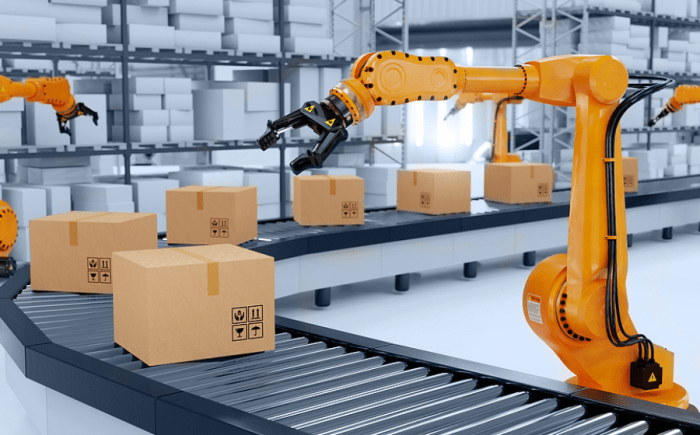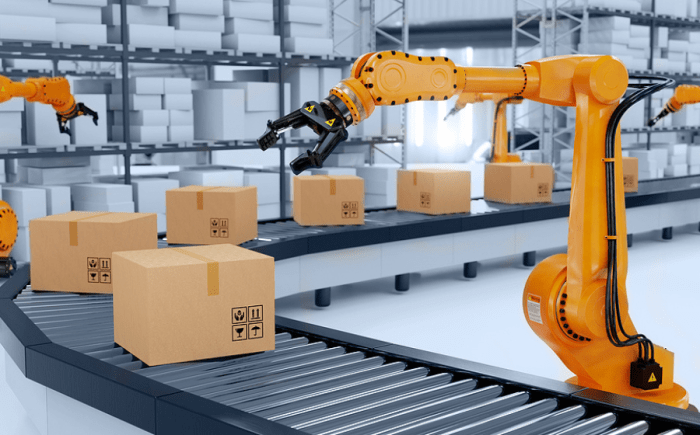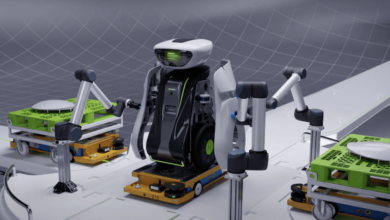
AI technology modernizes warehouse management, ushering in a new era of efficiency and optimization. Gone are the days of manual processes and clunky systems. Today, warehouses are embracing the power of AI to streamline operations, boost productivity, and deliver exceptional customer experiences.
Imagine a warehouse where robots autonomously navigate, inventory is managed with pinpoint accuracy, and orders are fulfilled with lightning speed. This isn’t science fiction; it’s the reality of AI-powered warehouses.
From inventory management to demand forecasting, AI algorithms are transforming every aspect of warehouse operations. The integration of AI-powered robots and automated guided vehicles (AGVs) is further revolutionizing the industry. These intelligent machines can perform repetitive tasks with precision and speed, freeing up human workers to focus on more complex and strategic activities.
The benefits of AI in warehouse management are undeniable, and companies are reaping the rewards of increased efficiency, reduced costs, and enhanced customer satisfaction.
The Evolution of Warehouse Management

Warehouses have always been the backbone of commerce, facilitating the storage and distribution of goods. However, the methods of managing these operations have evolved dramatically over time, driven by advancements in technology and the ever-increasing demands of modern supply chains.
Traditional Warehouse Management
Traditional warehouse management relied heavily on manual processes and paper-based systems. Tasks like inventory tracking, order fulfillment, and shipment scheduling were largely carried out by human workers, often with the aid of simple tools like barcode scanners and spreadsheets.
- Manual Inventory Tracking:Workers would physically count inventory items, update records manually, and maintain paper-based logs. This was a time-consuming and error-prone process, prone to inaccuracies and discrepancies.
- Paper-Based Order Fulfillment:Orders were processed manually, with workers picking items from shelves based on paper order slips. This process was inefficient, leading to delays and potential picking errors.
- Limited Real-Time Visibility:Traditional methods lacked real-time visibility into inventory levels, order status, and warehouse operations. This made it difficult to optimize processes and respond to changing demands.
Challenges Faced by Traditional Warehouse Operations
The limitations of traditional methods presented significant challenges for warehouse managers:
- Inventory Inaccuracies:Manual inventory tracking often resulted in inaccurate data, leading to stockouts, overstocking, and lost revenue.
- Inefficient Order Fulfillment:Manual picking and packing processes were slow and prone to errors, impacting order accuracy and delivery times.
- Lack of Real-Time Data:Limited visibility into warehouse operations hindered decision-making and optimization efforts.
- Increased Labor Costs:Manual processes required a large workforce, driving up labor costs and reducing overall efficiency.
AI-Powered Warehouse Management
The advent of AI has revolutionized warehouse management, offering solutions that address the challenges of traditional methods. AI-powered systems leverage machine learning, data analytics, and automation to optimize every aspect of warehouse operations, from inventory management to order fulfillment.
Efficiency and Effectiveness Comparison
| Feature | Traditional Methods | AI-Powered Solutions |
|---|---|---|
| Inventory Management | Manual tracking, prone to errors | Automated inventory tracking, real-time visibility, predictive analytics |
| Order Fulfillment | Manual picking and packing, slow and error-prone | Automated picking and packing, optimized routing, reduced errors |
| Warehouse Optimization | Limited data insights, inefficient processes | Data-driven insights, process optimization, improved resource allocation |
| Labor Costs | High labor costs, manual tasks | Reduced labor requirements, automation of repetitive tasks |
| Accuracy and Efficiency | Lower accuracy, slow processes | Higher accuracy, faster and more efficient operations |
AI Technologies Transforming Warehouses: Ai Technology Modernizes Warehouse Management

Artificial intelligence (AI) is revolutionizing warehouse management, automating tasks, optimizing processes, and improving efficiency. From inventory management to order fulfillment, AI is transforming how warehouses operate.
AI technology is revolutionizing warehouse management, optimizing processes from inventory tracking to order fulfillment. It’s amazing how this technology can even help me manage my own personal collection, like my my used book collection , which is constantly growing! And just like AI helps warehouses operate efficiently, it can also help me keep track of my books, ensuring I know exactly what I have and where it is.
AI Technologies Used in Warehouse Management
AI technologies are playing a crucial role in modern warehouse management. These technologies are used to collect and analyze data, optimize processes, and automate tasks. Here are some of the key AI technologies used in warehouse management:
- Machine Learning (ML):ML algorithms analyze historical data to identify patterns and make predictions. In warehouses, ML is used for demand forecasting, inventory optimization, and anomaly detection.
- Deep Learning (DL):DL is a subset of ML that uses artificial neural networks to analyze complex data. DL is used in image recognition, natural language processing, and predictive maintenance in warehouses.
- Computer Vision:Computer vision enables machines to “see” and interpret images. In warehouses, computer vision is used for object detection, quality control, and robotic navigation.
- Natural Language Processing (NLP):NLP enables machines to understand and interpret human language. In warehouses, NLP is used for voice-activated picking systems and chatbot-based customer support.
- Robotics:Robots are increasingly being used in warehouses to perform tasks such as picking, packing, and sorting. AI algorithms power these robots, enabling them to learn and adapt to changing environments.
- Automated Guided Vehicles (AGVs):AGVs are autonomous vehicles that navigate warehouses without human intervention. AI algorithms are used to control the movement and path planning of AGVs, ensuring efficient material handling.
AI Algorithms for Inventory Management
AI algorithms are used to optimize inventory levels and reduce storage costs. These algorithms analyze historical data, current demand, and supply chain factors to predict future demand and adjust inventory levels accordingly. This helps warehouses avoid stockouts and excess inventory.
- Demand Forecasting:AI algorithms use historical sales data, seasonal trends, and external factors like economic indicators to predict future demand. This helps warehouses plan inventory levels and ensure they have enough stock to meet customer orders.
- Inventory Optimization:AI algorithms optimize inventory levels by analyzing factors like lead times, storage costs, and demand variability. This helps warehouses minimize inventory holding costs and reduce the risk of stockouts.
- Anomaly Detection:AI algorithms can identify unusual patterns in inventory data, such as sudden spikes in demand or unexpected stockouts. This helps warehouses detect potential problems and take corrective action before they escalate.
AI Algorithms for Order Fulfillment
AI algorithms are used to optimize order fulfillment processes, reducing delivery times and improving customer satisfaction. These algorithms analyze order data, inventory levels, and shipping routes to optimize picking, packing, and shipping processes.
- Order Routing:AI algorithms optimize delivery routes by considering factors like traffic conditions, distance, and delivery deadlines. This helps warehouses reduce delivery times and improve efficiency.
- Picking Optimization:AI algorithms optimize picking routes and order batching to minimize travel time and improve picking efficiency. This helps warehouses reduce picking errors and improve order fulfillment speed.
- Automated Picking:AI-powered robots and AGVs are used to automate picking tasks, improving speed and accuracy. These robots can navigate warehouses autonomously, pick items from shelves, and deliver them to packing stations.
AI-Powered Robots and AGVs
AI-powered robots and AGVs are transforming warehouse operations by automating tasks, improving efficiency, and reducing labor costs. These robots can perform a wide range of tasks, including picking, packing, sorting, and transporting goods.
- Picking and Packing:Robots equipped with advanced vision systems can identify and pick items from shelves with high accuracy. They can also pack items into boxes and prepare them for shipment.
- Sorting and Distribution:AGVs can move goods around warehouses, transporting them to different locations for sorting, packing, or shipment. This reduces manual labor and improves efficiency.
- Inventory Management:Robots and AGVs can scan inventory items, track their location, and update inventory records in real-time. This provides accurate inventory data and helps warehouses optimize inventory levels.
Benefits of AI in Warehouse Management
The integration of AI in warehouse management has ushered in a new era of efficiency, productivity, and cost optimization. AI algorithms can analyze vast amounts of data, identify patterns, and make predictions that enhance decision-making and streamline operations. By leveraging AI, warehouses can optimize resource allocation, minimize errors, and ultimately achieve significant improvements in their overall performance.
Increased Efficiency and Productivity
AI technologies can significantly enhance warehouse efficiency and productivity by automating repetitive tasks, optimizing resource allocation, and minimizing downtime.
- Automated Picking and Packing:AI-powered robots can accurately and efficiently pick and pack orders, reducing the need for manual labor and minimizing errors. This frees up human workers to focus on more complex tasks that require human judgment and problem-solving skills.
- Optimized Route Planning:AI algorithms can analyze warehouse layout, order volume, and other factors to create optimal routes for forklifts and other equipment, minimizing travel time and maximizing efficiency. This leads to faster order fulfillment and improved productivity.
- Predictive Maintenance:AI can monitor equipment performance and predict potential failures, enabling proactive maintenance and reducing downtime. By identifying and addressing issues before they become major problems, AI helps ensure the smooth operation of warehouse equipment and minimizes disruptions to workflow.
Improved Inventory Accuracy and Reduced Stockouts
AI plays a crucial role in optimizing inventory management by providing real-time insights into stock levels, demand patterns, and potential stockouts.
- Real-Time Inventory Tracking:AI-powered systems can track inventory in real time, providing accurate data on stock levels, locations, and movement. This enables warehouse managers to make informed decisions about inventory replenishment and avoid stockouts.
- Demand Forecasting:AI algorithms can analyze historical sales data, seasonal trends, and other factors to predict future demand for products. This allows warehouses to optimize inventory levels, reducing the risk of stockouts and minimizing holding costs.
- Automated Inventory Adjustment:AI systems can automatically adjust inventory levels based on real-time demand and supply data. This ensures that warehouses have the right amount of inventory on hand to meet customer needs while minimizing waste and storage costs.
Enhanced Decision-Making and Operational Optimization
AI-powered analytics provide valuable insights into warehouse operations, enabling data-driven decision-making and continuous improvement.
AI technology is revolutionizing warehouse management, optimizing processes from inventory tracking to order fulfillment. But for seamless integration, it’s crucial to have efficient communication and scheduling tools. That’s where Microsoft Outlook iOS scheduling comes in handy, allowing warehouse managers to coordinate tasks and deliveries with ease, ensuring smooth operations and faster turnaround times.
This, combined with AI-powered insights, helps create a truly modern and streamlined warehouse ecosystem.
- Performance Monitoring and Analysis:AI can monitor warehouse performance metrics, such as order fulfillment rate, picking accuracy, and inventory turnover, and identify areas for improvement. This data can be used to optimize processes, allocate resources effectively, and improve overall warehouse efficiency.
- Predictive Analytics:AI can analyze historical data and identify patterns to predict future trends and potential challenges. This allows warehouse managers to anticipate problems, make proactive adjustments, and avoid disruptions to operations.
- Scenario Planning:AI can be used to model different scenarios and assess the impact of potential changes on warehouse operations. This helps managers make informed decisions about resource allocation, process optimization, and other strategic initiatives.
Implementing AI in Warehouses
Integrating AI into warehouse operations can be a game-changer, but it requires a well-defined strategy and careful execution. This section delves into the practical aspects of implementing AI in warehouses, outlining a step-by-step guide and exploring considerations for selecting and integrating AI solutions.
AI technology is revolutionizing warehouse management, optimizing processes and increasing efficiency. It’s amazing how AI can analyze data and predict demand, ensuring that the right products are in the right place at the right time. While I’m busy thinking about how AI can improve logistics, I’m also dreaming about a delicious garlic butter pizza crust – maybe a future AI-powered pizza delivery system can bring one straight to my door! The possibilities with AI are endless, from managing warehouses to delivering our favorite food.
Steps for Implementing AI in Warehouses
Implementing AI in warehouses involves a systematic approach, moving from planning and assessment to deployment and optimization. Here’s a step-by-step guide:
- Identify Business Objectives:Clearly define the specific business goals you aim to achieve with AI, such as optimizing inventory management, improving order fulfillment speed, or enhancing warehouse safety.
- Data Collection and Analysis:Gather relevant data from various warehouse operations, including inventory levels, order history, employee performance, and operational metrics. This data will be the foundation for training AI models.
- AI Solution Selection:Evaluate different AI technologies and solutions based on your specific needs. Consider factors such as cost, scalability, ease of integration, and the availability of skilled personnel to manage the technology.
- Pilot Implementation:Begin with a pilot project to test the selected AI solution in a controlled environment. This allows you to assess its effectiveness, identify potential challenges, and refine the implementation strategy.
- Deployment and Integration:Once the pilot project is successful, gradually roll out the AI solution across the entire warehouse, ensuring seamless integration with existing systems and workflows.
- Continuous Monitoring and Optimization:Regularly monitor the performance of the AI solution, gather feedback from warehouse staff, and make necessary adjustments to optimize its effectiveness.
Considerations for Selecting and Integrating AI Solutions
Selecting and integrating AI solutions requires careful consideration of various factors:
- Data Quality:Ensure the data used to train AI models is accurate, complete, and relevant to the specific tasks. Poor data quality can lead to inaccurate predictions and inefficient AI performance.
- Scalability and Flexibility:Choose solutions that can scale with your business growth and adapt to changing warehouse needs.
- Security and Privacy:Implement robust security measures to protect sensitive data and comply with privacy regulations.
- Integration with Existing Systems:Ensure the AI solution integrates seamlessly with your current warehouse management systems (WMS), enterprise resource planning (ERP), and other relevant software.
- Training and Support:Provide adequate training for warehouse staff to understand how to use and interact with the AI solution. Ensure access to technical support for ongoing maintenance and troubleshooting.
Key Steps in Implementing AI in a Warehouse
| Step | Description |
|---|---|
| 1. Identify Business Goals | Define the specific objectives you aim to achieve with AI, such as optimizing inventory management, improving order fulfillment speed, or enhancing warehouse safety. |
| 2. Data Collection and Preparation | Gather relevant data from various warehouse operations, including inventory levels, order history, employee performance, and operational metrics. Cleanse and prepare the data for AI model training. |
| 3. AI Solution Selection | Evaluate different AI technologies and solutions based on your specific needs, considering factors such as cost, scalability, ease of integration, and the availability of skilled personnel. |
| 4. Pilot Implementation | Test the selected AI solution in a controlled environment to assess its effectiveness, identify potential challenges, and refine the implementation strategy. |
| 5. Deployment and Integration | Gradually roll out the AI solution across the entire warehouse, ensuring seamless integration with existing systems and workflows. |
| 6. Continuous Monitoring and Optimization | Regularly monitor the performance of the AI solution, gather feedback from warehouse staff, and make necessary adjustments to optimize its effectiveness. |
Case Studies of AI in Warehouse Management
The practical application of AI in warehouse management is not just a theoretical concept; it’s a reality shaping the industry. Several companies have successfully integrated AI solutions, experiencing significant improvements in efficiency, accuracy, and customer satisfaction. These case studies demonstrate the real-world impact of AI on warehouse operations and provide valuable insights for businesses considering implementing similar technologies.
Examples of AI-Powered Warehouse Management, Ai technology modernizes warehouse management
Here are some real-world examples of how AI is transforming warehouse operations:
| Company | AI Technology | Application | Impact |
|---|---|---|---|
| Amazon | Robotics, Machine Learning | Automated picking and packing, warehouse optimization | Increased efficiency, reduced costs, faster order fulfillment |
| Walmart | Computer Vision, Machine Learning | Inventory management, demand forecasting, shelf-scanning | Improved inventory accuracy, reduced stockouts, optimized pricing strategies |
| Ocado | Robotics, Machine Learning | Automated order fulfillment, warehouse automation | Highly efficient order picking, reduced human error, high-volume order processing |
| DHL | Machine Learning, Predictive Analytics | Route optimization, delivery planning, predictive maintenance | Optimized delivery routes, reduced fuel consumption, improved vehicle maintenance |
Benefits Experienced by Companies
AI-powered warehouse management offers a range of benefits, including:
- Increased Efficiency:Automation of tasks like picking, packing, and sorting leads to faster processing times and increased throughput.
- Reduced Costs:AI-driven optimization of warehouse operations reduces labor costs, minimizes errors, and optimizes inventory levels, leading to significant cost savings.
- Improved Accuracy:AI-powered systems are less prone to errors than human workers, resulting in improved inventory accuracy and fewer order fulfillment issues.
- Enhanced Customer Satisfaction:Faster order fulfillment, improved accuracy, and better delivery predictability contribute to increased customer satisfaction.
- Better Decision-Making:AI provides real-time data and insights, enabling better decision-making regarding inventory management, resource allocation, and operational planning.
Challenges Faced by Companies
While the benefits are significant, implementing AI in warehouses also presents challenges:
- High Initial Investment:Implementing AI solutions requires significant upfront investment in technology, infrastructure, and training.
- Data Requirements:AI systems require large amounts of data to function effectively, and companies need to ensure data quality and accessibility.
- Integration Challenges:Integrating AI systems with existing warehouse management systems can be complex and require careful planning and execution.
- Security Concerns:Data security and privacy are critical considerations when implementing AI solutions, especially in sensitive environments like warehouses.
- Skills Gap:Finding skilled personnel to manage and maintain AI systems can be challenging, as the industry requires specialized expertise.
Impact of AI on Warehouse Operations
AI is transforming warehouse operations in various ways:
- Automated Picking and Packing:Robots and automated systems are taking over tasks like picking, packing, and sorting, reducing human involvement and increasing efficiency.
- Inventory Optimization:AI-powered systems can analyze data to predict demand, optimize inventory levels, and reduce stockouts or overstocking.
- Warehouse Layout Optimization:AI algorithms can analyze warehouse layouts and recommend improvements to optimize space utilization and workflow efficiency.
- Predictive Maintenance:AI can monitor equipment performance and predict potential failures, enabling proactive maintenance and reducing downtime.
- Real-Time Tracking and Visibility:AI systems provide real-time visibility into warehouse operations, allowing managers to track inventory, monitor workflows, and identify potential bottlenecks.
Impact of AI on Customer Satisfaction
AI-driven improvements in warehouse operations directly impact customer satisfaction:
- Faster Order Fulfillment:Automated processes lead to faster order processing and delivery, enhancing customer satisfaction with faster delivery times.
- Improved Order Accuracy:AI-powered systems reduce errors, leading to fewer incorrect orders and improved customer satisfaction with accurate order fulfillment.
- Enhanced Delivery Predictability:AI-powered route optimization and delivery planning improve delivery predictability, enhancing customer satisfaction with reliable delivery estimates.
- Personalized Experiences:AI can analyze customer data to personalize shopping experiences, providing recommendations and tailored promotions that enhance customer satisfaction.
Impact of AI on Overall Business Outcomes
The benefits of AI in warehouse management extend beyond operational improvements to impact overall business outcomes:
- Increased Revenue:Improved efficiency, accuracy, and customer satisfaction lead to increased sales and revenue generation.
- Reduced Costs:AI-driven optimization reduces operational costs, leading to improved profitability and financial performance.
- Enhanced Competitiveness:AI-powered warehouse management enables businesses to stay ahead of the competition by offering faster delivery, improved accuracy, and a better customer experience.
- Sustainable Operations:AI can optimize resource utilization, reduce waste, and improve energy efficiency, contributing to more sustainable warehouse operations.
The Future of AI in Warehouse Management

The future of warehouse management is intricately intertwined with the continuous evolution of AI technologies. As AI capabilities mature, we can expect to see even more sophisticated applications transforming warehouse operations, driving efficiency, and optimizing logistics across the entire supply chain.
The Role of AI in Shaping the Future of Supply Chain Logistics and E-commerce
AI is poised to play a pivotal role in shaping the future of supply chain logistics and e-commerce, influencing various aspects:* Predictive Analytics for Demand Forecasting:AI algorithms can analyze historical data, market trends, and external factors to provide accurate demand forecasts. This enables businesses to optimize inventory levels, reduce stockouts, and minimize waste.
Real-time Inventory Management
AI-powered systems can track inventory in real-time, providing visibility into stock levels, locations, and movement. This allows for efficient order fulfillment, reduced lead times, and minimized errors.
Automated Warehouse Operations
Robots and autonomous vehicles powered by AI can perform tasks such as picking, packing, and transporting goods, freeing up human workers for more complex tasks. This automation increases efficiency, reduces labor costs, and improves safety.
Personalized Customer Experiences
AI can personalize customer experiences by analyzing data on past purchases, preferences, and browsing behavior. This allows for tailored recommendations, targeted promotions, and improved customer satisfaction.
Optimized Delivery Routes
AI algorithms can optimize delivery routes, taking into account factors such as traffic conditions, weather, and distance. This results in faster delivery times, reduced fuel consumption, and lower transportation costs.






